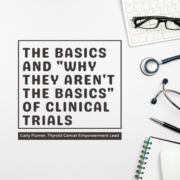The Basics and “Why They Aren’t The Basics” of Clinical Trials
We’ve all heard about clinical trials, especially with the recent pandemic (for which there are still ongoing trials available!). But it’s not always intuitive on how to find trials, how to enroll in them, what goes into them, and how there still is (and how we can fix!) the lack of diversity in trials despite efforts. Therefore, this blog is specifically dedicated to just that! If you have additional insights, feel free to reach out in the comments or email me at carly@powerfulpatients.org so that this can be updated!
First, let’s break down what a clinical trial is not. A clinical trial is not a method of care that the healthcare community tries to take discriminatory advantage of. Although it has been that way in the past, especially amongst the African American community, I believe trials are trying to do a better job when it comes to equity and inclusion of multiple races and ethnicities, as well as clear consent. Clinical trials are a way to advance medical sciences and treatment initiatives for patients around the world experiencing the same diseases and conditions that make us vulnerable. Clinical trials aren’t always looking for treatment opportunities, however, some trials are focused on prevention, the feasibility and/or safety of a medical device, or on quality of life. No matter the type of trial, though, there is always something to be learned to enhance healthcare in a number of ways, even if it’s not easily recognizable.
Doctors sometimes do not mention clinical trials as a treatment option because they feel like they are “giving their patients away.” After all, healthcare is a business, and if a doctor “loses” their patient to a trial, it’s not the most economical option for them. This is another reason why we have to be advocates of our own health and do research.
Clinical trials can be found doing a quick Google search, on www.clinicaltrials.gov, or by going to a local or national hospital’s website and searching for available trials. Most hospital systems will direct to clinicaltrials.gov if there’s a record for the trial because it contains the most information, including the purpose of the trial, the outcome(s) the investigators are looking for, eligibility criteria, and what will be happening during the trial and for how long. A patient can bring this information to their doctor and ask if it’s appropriate for them. If so, the trial generally lists who and how to contact at the bottom of the record on clinicaltrials.gov or on the hospital’s website. What it doesn’t tell you is if you’ll be compensated for your time, which may hinder trial enrollment.
Compensation information for a trial, if applicable, can be found in the informed consent document, which is an official document that includes what will happen in a trial and for how long, what the objectives of the study are, compensation information, and the risks/benefits of participation. Compensation in clinical trials is considered a “recruitment incentive,” not necessarily to obscure the risks and/or benefits of a trial. According to the NIH, the FDA doesn’t consider reimbursement for travel, lodging, airfare, and/or parking, but for “their time, inconvenience, discomfort, or some other consideration.” Usually, it’s in the form of a gift card, and “any credit for payment should accrue as the study progresses and not be contingent upon the subject completing the entire study.”
Given that patients would be paid to participate, does this help break down barriers for vulnerable populations? It may not be enough. Patients are not responsible for routine care costs during a trial if they’re covered under private insurance or Medicare. However, as stated above, patients are not reimbursed for travel, lodging, airfare, and/or parking. Depending on how far the patient has to travel and where, the gas money, much less airfare, and hotel costs could drive up the costs exponentially. This is especially true in major metropolitan areas as opposed to more rural or suburban areas, as there may be more local trial locations such as hospitals and clinics.
How do we increase diversity in such important potential medical discoveries? The FDA suggests that study sponsors are “encouraged to think about reducing visit frequency, when appropriate, in addition to considering whether flexibility in visit windows is possible and whether electronic communications, such as phone, email, social media platforms, or other digital health technology tools can replace site visits and provide investigators with real-time data.” Tying this advice back to patient compensation, electronic communications replacing in-person could be a game-changer for patients. If Covid hadn’t forced some medical offices to close and offer virtual visits, it couldn’t have come any sooner. Additionally, continue to have clinical trials that are for specific patient populations, as applicable to specific diseases (for example, breast cancer trials for African American men and women). Finally, establish networks in the local community, and go where the patients are. Learn about them. Clinical trial enrollment can only get better if we step out of the board room and into the classroom.
Carly Flumer is a young woman who was diagnosed with stage I papillary thyroid cancer at the age of 27. She recently received her Master’s degree from Boston University in Health Communication and received her Bachelor’s from George Mason University in Health Administration and Policy. While being diagnosed with the “C” word at such a young age was a surprise, as it would be to anyone, she found strength, support, and inspiration in sharing her cancer journey on social media. As a result of her health outcome, she looks to advocate for other cancer patients through education, research, and health literacy.




